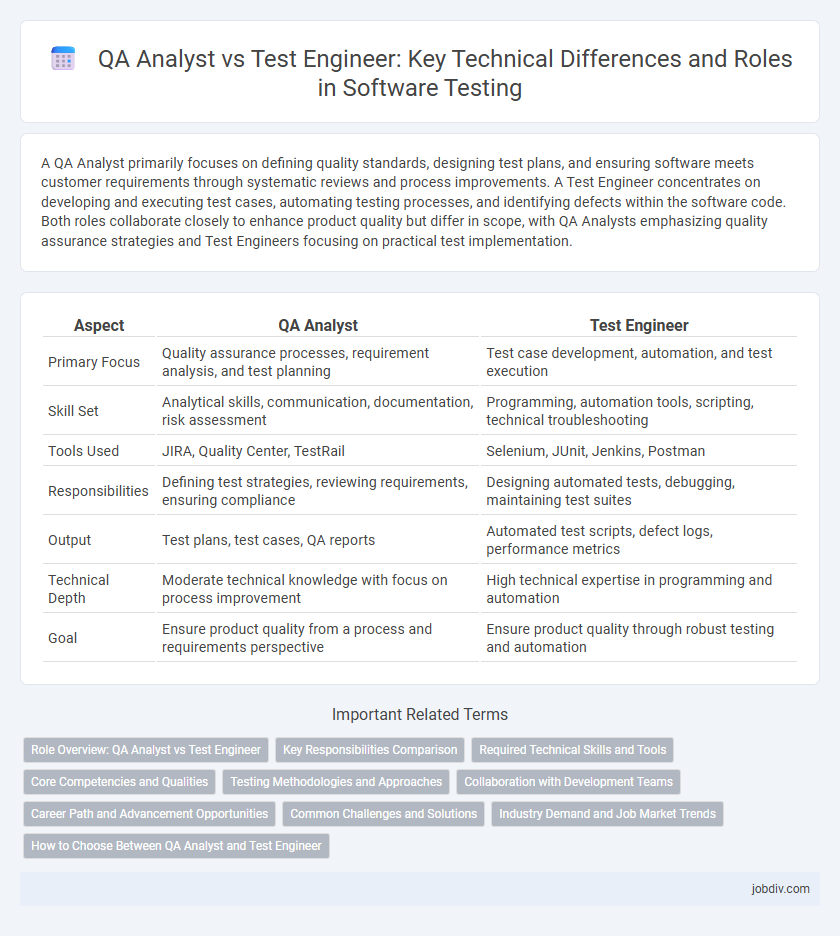A QA Analyst primarily focuses on defining quality standards, designing test plans, and ensuring software meets customer requirements through systematic reviews and process improvements. A Test Engineer concentrates on developing and executing test cases, automating testing processes, and identifying defects within the software code. Both roles collaborate closely to enhance product quality but differ in scope, with QA Analysts emphasizing quality assurance strategies and Test Engineers focusing on practical test implementation.
Table of Comparison
| Aspect | QA Analyst | Test Engineer |
|---|---|---|
| Primary Focus | Quality assurance processes, requirement analysis, and test planning | Test case development, automation, and test execution |
| Skill Set | Analytical skills, communication, documentation, risk assessment | Programming, automation tools, scripting, technical troubleshooting |
| Tools Used | JIRA, Quality Center, TestRail | Selenium, JUnit, Jenkins, Postman |
| Responsibilities | Defining test strategies, reviewing requirements, ensuring compliance | Designing automated tests, debugging, maintaining test suites |
| Output | Test plans, test cases, QA reports | Automated test scripts, defect logs, performance metrics |
| Technical Depth | Moderate technical knowledge with focus on process improvement | High technical expertise in programming and automation |
| Goal | Ensure product quality from a process and requirements perspective | Ensure product quality through robust testing and automation |
Role Overview: QA Analyst vs Test Engineer
QA Analysts focus on defining test strategies, analyzing requirements, and ensuring that software meets business objectives through detailed validation processes. Test Engineers concentrate on designing, developing, and executing automated and manual test cases to identify defects and improve software quality through technical expertise. Both roles collaborate closely to deliver defect-free software but differ in emphasis on strategic analysis versus technical implementation.
Key Responsibilities Comparison
QA Analysts specialize in ensuring software quality by designing test plans, identifying defects, and validating functionality against requirements to enhance product reliability. Test Engineers focus on creating and executing automated test scripts, developing testing frameworks, and integrating continuous testing processes within CI/CD pipelines to improve test efficiency. Both roles collaborate closely to deliver high-quality software but differ primarily in manual versus automated testing emphasis and scope of technical involvement.
Required Technical Skills and Tools
QA Analysts require expertise in test case design, requirements analysis, and proficiency with tools like JIRA, TestRail, and SQL for validating data integrity. Test Engineers demand advanced skills in automated testing frameworks such as Selenium, Jenkins, and performance testing tools like LoadRunner, alongside programming knowledge in languages like Java, Python, or C#. Both roles benefit from familiarity with Continuous Integration/Continuous Deployment (CI/CD) pipelines and version control systems like Git, but Test Engineers often engage more deeply in scripting and developing test automation suites.
Core Competencies and Qualities
QA Analysts excel in analytical skills, attention to detail, and proficiency in requirement analysis and defect tracking, ensuring thorough validation of software functionality. Test Engineers demonstrate strong programming skills, automation expertise, and knowledge of test frameworks to design and implement robust test scripts for performance and regression testing. Both roles require a deep understanding of software development lifecycles, but QA Analysts focus more on quality assurance processes while Test Engineers emphasize technical execution and automation.
Testing Methodologies and Approaches
QA Analysts primarily focus on defining quality standards and validating requirements through manual testing and exploratory testing methodologies, ensuring alignment with business objectives. Test Engineers emphasize designing, developing, and maintaining automated test scripts and frameworks using approaches like unit testing, integration testing, and continuous integration (CI) pipelines to enhance test efficiency and coverage. Both roles collaborate to implement comprehensive testing approaches, combining manual and automated techniques to optimize defect detection and software reliability.
Collaboration with Development Teams
QA Analysts focus on defining test requirements and ensuring alignment with business goals through continuous communication with developers. Test Engineers collaborate closely with development teams to design and implement automated testing frameworks that integrate seamlessly into the CI/CD pipeline. Both roles prioritize early defect detection and fostering a feedback loop to enhance software quality throughout the development lifecycle.
Career Path and Advancement Opportunities
QA Analysts often start with responsibilities in test case development and bug tracking, progressing toward roles like QA Lead or Test Manager by gaining expertise in quality processes and project coordination. Test Engineers typically advance by deepening technical skills in automation, performance, and security testing, leading to positions such as Automation Architect or Engineering Manager. Both career paths value continuous learning, certifications, and cross-functional experience to enhance advancement opportunities in software quality assurance.
Common Challenges and Solutions
QA Analysts and Test Engineers often face overlapping challenges such as ambiguous requirements, which lead to incomplete test coverage and increased defect leakage. Implementing clear communication channels between stakeholders and adopting behavior-driven development (BDD) frameworks can mitigate these issues by aligning test scenarios with user expectations. Utilizing automated testing tools and continuous integration pipelines addresses repetitive testing tasks, improving efficiency and reducing human error.
Industry Demand and Job Market Trends
The demand for QA Analysts rose by 15% in 2023, driven by businesses prioritizing user experience and regulatory compliance, while Test Engineers saw a 20% increase due to the growing adoption of automation and continuous integration practices. Industry trends indicate that Test Engineers with skills in scripting languages and DevOps tools are more sought after in tech startups and large enterprises focusing on agile methodologies. QA Analysts continue to be essential in sectors like finance and healthcare where manual testing and documentation remain critical for quality assurance.
How to Choose Between QA Analyst and Test Engineer
Choosing between a QA Analyst and a Test Engineer depends on project needs and skill sets; QA Analysts focus on designing test plans, analyzing requirements, and ensuring quality standards, while Test Engineers emphasize automation, test development, and technical execution. Consider the complexity of the software, automation requirements, and whether the role demands deep coding expertise or process-oriented quality assurance. Evaluating team goals and technological stack helps determine if a quality-focused strategist or a technically skilled tester aligns best with the project.
QA Analyst vs Test Engineer Infographic

 jobdiv.com
jobdiv.com